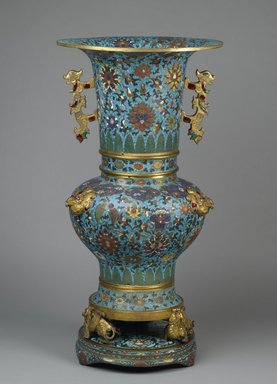
Medium: Cloisonné enamel on copper alloy, gilt bronze, semi-precious stones
Geograhical Locations:
Dates:17th–mid 18th century
Dimensions: 41 1/2 x 22 in. (105.4 x 55.9 cm)
Collections:
Accession Number: 09.933.2
Image: 09.933.2_PS2.jpg,
Catalogue Description: Ta shu fu p'ing (grand imperial vase). Beaker shaped, in five sections, with archaic gilt bronze dragon and phoenix handles, richly studded with semi-precious stones. Trumpet-shaped neck, with turquoise-blue enamel ground, sustaining chrysanthemum flowers and varied border motives in typical Ming colors; the bulbous body below presents a similar turquoise-blue ground, with conventional lotus flowers and scrolling vines, interspersed with the familiar eight Buddhist emblems (pa chi-hsiang) of happy omen. The shoulder, finished by a deep blue lanceolated bordering, supports three projecting gilt bronze phoenix birds, with studding of semi-precious stones, matching the two dragon handles at the neck. The vase, raised upon three gilt bronze winged lions, rests upon a cloisonné stand, which bears a circular "shou" character in dark blue, surrounded by conventional lotus flowers and leafy scrolls in characteristic colors of its period. A homogenous ensemble is presented, with great decorative force. Special mark (surrounded by dragons) reads: "Da Ming Jingtai nian zhi," made in the reign of Emperor Jingtai (1450-1456) of the great Ming dynasty. From the palace of the Empress at Peking. (The above information is taken for the most part from the Getz catalogue of the Avery Cloisonné. Please note that the piece was dismantled in the spring of 1953 and is now in five different parts as curator felt center section (see photo) is earlier than the other segments.